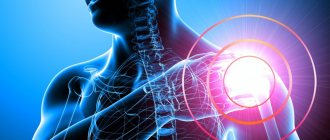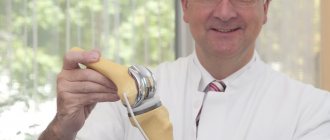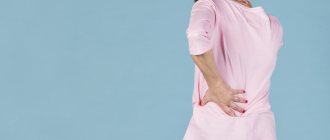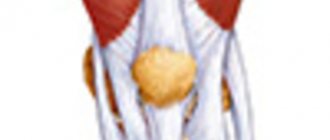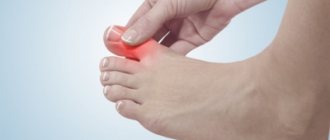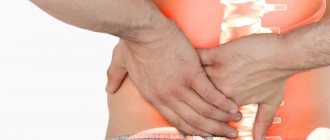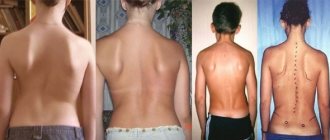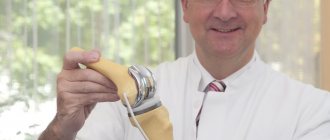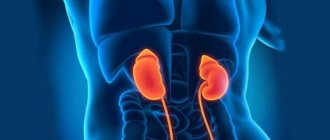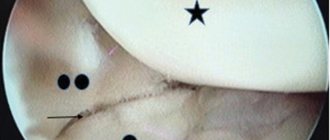Author of the article: Nivelichuk Taras, head of the department of anesthesiology and intensive care, work experience 8 years. Higher education in the specialty “General Medicine”.
Article publication date: 08/13/2016
Article updated date: 01/28/2020
Salt deposition in the joints is the accumulation of uric acid salts (urates) in the joint structures. Accumulating in tissues, urate crystals destroy cartilage and bone tissue, causing pain and inflammation. Crystals have different localizations; Several joints may be affected at the same time.
Damage to the joint due to the deposition of uric acid salts in it
In addition to joints, these same salts can be deposited in other organs - for example, in the kidneys or subcutaneous tissue.
Deposition of salts in subcutaneous tissue
Another name for this pathology is gout. This is not an independent disease, it occurs as a result of metabolic disorders.
At the initial stage, deposited salts do not manifest themselves with any specific symptoms. However, over time, the accumulation of needle-like urates leads to unbearable pain attacks and severe inflammation.
This problem is dealt with by a general practitioner.
General blood and urine tests will help detect excess uric acid and prevent the development of gout. At an early stage of the development of the disease, before the manifestation of its clinical signs, they are a reliable diagnostic method for salt deposition.
This disorder can be successfully treated and controlled.
Further from the article you will learn how salt deposition occurs, what are the methods for detecting them, and how to properly treat and prevent this pathology.
Causes of salt deposits
The main causes of salt deposition in the body are changes in metabolism in the joints themselves and impaired kidney function (insufficient excretion of uric acid). Often the process is triggered by a combination of reasons: metabolic disorders (metabolism) and the presence of several provoking factors (the more of them, the more serious the disease).
Possible provoking factors:
- poor nutrition;
- lack of physical activity;
- hypothermia of joints;
- musculoskeletal injuries;
- prolonged excessive stress on the joints;
- overweight;
- drinking alcoholic beverages.
If there is the slightest disruption in metabolism, any of the listed factors can trigger the process of disruption of the joint structures (and other organs) and the deposition of salts in them. Normally, a healthy joint is able to cope with “excesses” of something and eliminate them, preventing the occurrence of pathology. But if its functions are impaired for some reason, and the protective mechanisms do not work, then the salt crystals will firmly settle in it and begin destructive actions.
Recipes for cleaning joints
There are several most effective ways to cleanse salts. But you only need to choose one.
Cleansing with rice
Boiled rice perfectly absorbs salts, and it is this ability that is important when cleaning joints. Just keep in mind that potassium is also excreted at the same time, so its deficiency in the body must be replenished.
A glass of rice should be filled with two glasses of water and left overnight. In the morning, boil and rinse. Divide into 4 equal parts and eat throughout the day.
The next day everything repeats itself. But before eating you need to drink 100 ml of water, and add boiled beets and a fresh apple to the rice.
Lead a normal lifestyle for three days, but do not indulge in smoked, salted or fried foods. And then repeat the cleaning.
This must be done for two months.
Bay leaf cleansing
This method, which is also called the Semenova method, perfectly cleanses the joints and has a beneficial effect on the entire body.
Crush a couple of large bay leaves (about 5 grams) in a mortar or just mash well with your hands. Place in a small saucepan. Pour 300 ml of boiling water. After boiling, boil for 5 minutes over low heat, then pour into a thermos and leave for 5-6 hours. Strain. Take several small sips every 40 minutes throughout the day.
Continue taking for three days. Then take a break for a week and repeat.
Radish cleansing
Black radish juice is a very effective joint cleanser. But it must be prepared correctly. 10 kg of black radish should be washed and dipped directly in the peel into a solution of potassium permanganate for half an hour. Then remove, allow excess liquid to drain, grate on a coarse grater and squeeze out the juice.
Take exactly 30 ml three times a day until the juice runs out. Do not exceed the dose.
During the cleansing period, you should avoid harmful foods in your diet and opt for vegetables and fruits.
Mechanism of salt deposition
You can often hear that osteophytes are the result of salt deposition. This statement is incorrect: osteophytes are a protective (albeit pathological) compensatory reaction of the body; they have a structure identical to bones and a different mechanism of formation (compared to the deposition of salts).
In joint tissues (and other tissues where deposition can occur), uric acid salt, a breakdown product of purines, accumulates. Purines are sodium urates that are formed if uric acid is found in excess for some reason. When there is a lot of it, it combines with sodium and moves with the blood to the legs.
On their way, salts can enter the joint and remain there, especially if it is weakened for some reason. Once in the joint fluid, urates are deposited in the tissues. Urate crystals have a pointed shape, they penetrate all the way to the bone, accumulating near it and injuring it - as a result, such deposition of salts in the joints causes pain and inflammation.
Uric acid crystals under a microscope
Urates can also accumulate in other organs and tissues - for example, in the kidneys, causing kidney failure and stones. Urates can also be deposited under the skin: on the forehead, ears, in the joint area - such formations in the form of subcutaneous sacs are called tophi. Tophi are filled with white granular (curdled) contents; may open.
Symptoms of the disease
The following symptoms are signs of gonarthrosis:
- pain in the knee joint that occurs during heavy physical exertion. By the way, pain can also be localized in the lower leg area;
- stiffness, limited joint mobility. After a long period of rest, the joint cannot function normally without preliminary “development”;
- “crunching” in the joint when moving;
- “tumor” (increase in volume) and swelling in the joint area;
- loss of full movement in the joint (the leg does not straighten or bend completely);
- increased temperature in the area of the affected joint.
Diagnostics
When the process has already gone far, making a diagnosis and detecting salts in the joints is not difficult. The presence of salts at the initial stage can be determined by blood and urine tests by contacting a physician.
A blood uric acid level of more than 415 µmol/l is the first sign of urate deposition in the joints (even without obvious concomitant disorders of the kidneys or the joints themselves). Urine density is an indicator of whether uric acid is leaving the body in sufficient quantities; a value of this indicator below 1015 indicates that the acid remains inside, that is, accumulates.
Another procedure that allows you to determine the deposition of salts in the body is the study of joint fluid in a polarizing microscope. If crystals of uric acid salts are found in it, you will need to undergo additional examination of the joints (for example, x-ray).
Literature
- VC. Bauman, “Biochemistry and physiology of vitamin D” Riga, Zinatye, 1989, 480 p.
- Fleisch, Bisphosphonates in bone disease, 1997, London, 184p.
- Feldman, D., and Mallon, P. J. and Gross, C. (1996). Vitamin D: metabolism and action.In Marcus, R., Feldman, D. and Kelsey, J. (eds) Osteoporosis, pp.205-35. (San Diego: Academic Press).
- Bushinsky, D. A. and Krieger, N. S. (1992). Integration of calcium metabolism in the adult. In Coe, FL and Favus, MJ (eds.) Disorders of Bone and Mineral Metabolism, pp.417-32. (New York: Raven Press).
- O.G.Arkhipova, E.A. Yuryeva, N.M. Dyatlova, “Prospects for the use of xydiphone”, J. Vses. chem. total them. DI. Mendeleeva, 1984, XXIX, 3, pp. 76-80.
- T.A. Matkovskaya, N.P. Tatarnikova, etc. Pat. RF RU 2124881 C1.
- E.A. Yuryeva, I.P. Dunaeva, G.I. Kulakova “The effectiveness of xydiphone depending on the method of its use”, In: New chelating agent xydiphone. Pharmacology, toxicology and therapy. Moscow, 1990, pp. 62-70.
(The article is abbreviated. The full text was published in the journal: Cosmetics and Medicine, 1999, No. 5/6, p. 71.)
Three treatment methods
Medicines
For pain and inflammation of the joints of any cause (including the deposition of salts in them), non-steroidal anti-inflammatory drugs (NSAIDs) are used:
- diclofenac,
- ketorolac,
- naproxen,
- ibuprofen and others.
Along with drug therapy, diet and physiotherapeutic procedures are prescribed.
Nutrition for salt deposits
An important point in the treatment and prevention of salt deposits (gout) is nutrition. If the diet is incorrect and unbalanced, it can cause metabolic disorders and salt deposition in the joints; This is especially true for people who like to eat a lot and drink alcohol. To reduce the amount of uric acid in the blood and stop the progression of the pathology, you need to follow a special diet.
The table below lists foods that should be avoided and/or limited if you have gout, and those that you can eat.
(if the table is not completely visible, scroll to the right)
| Can | Limit | It is forbidden |
| Wholemeal bread | Pork | Premium bread |
| Vegetables | Jelly | Butter dough |
| Sour cream | Fats | |
| Bean soups | ||
| Fruits | Eggs | Sausages |
| Mayonnaise | ||
| Cheese | Ham | |
| Lean beef | Cereals | Canned food |
| Lean fish | Pickled products | Smoked products |
| Seafood | Butter | Sauces |
| Chicken without skin | ||
| Milk | ||
| Dairy products | ||
| Cottage cheese |
Men of any age and women in menopause should pay special attention to diet. The restriction for women is due to the fact that the hormone estradiol, which is produced in women before menopause, to a certain extent protects the body from the accumulation of salts and the development of gout.
The use of folk remedies
Numerous folk methods for removing salts from joints are especially popular. The use of such methods allows you to enhance the effect of dietary nutrition, speed up cleansing of the body, and prevent various disorders.
Folk remedies for removing salt:
- Bay decoction. During the cleansing period using the presented method, it is not recommended to expose the body to hypothermia or intense physical activity. To prepare 5 bay leaves, pour 0.5 liters of water and then boil for 20 minutes. The finished medicine is divided into 2-3 doses, which are drunk during the day. The duration of treatment is from 3 to 5 days, as this is a potent drug.
- Dandelion decoction. The leaves of the plant are used for preparation. They must be washed with water and placed in a saline solution for 20 minutes. After this, repeated washing is carried out. The finished mixture is squeezed through cheesecloth, mixed with water in the same ratio and boiled for 3-5 minutes. The finished medicine is taken in the morning and evening before meals, 50 g.
- Lilac infusion. Dried flowers must be mixed with vodka (1 to 10). The product is infused in a tightly closed container for 10 days. The finished medicine is taken once a day, 30 drops. The product can also be used to rub a sore joint or as a compress liquid.
- Decoction of sunflower roots. The root is crushed into pieces no larger than 1 cm. It is recommended to prepare the medicine in an enamel container. For 1 cup of roots you need to add 3 liters of water. The medicine is boiled for 2 minutes, after which it is taken 3 times a day after meals for 3 weeks.
- Decoction of lingonberry leaves. The dried plant material is thoroughly crushed, after which 1 spoon of powder is poured with 1 cup of boiling water. The medicine should be infused for 30 minutes, after which it should be drunk warm. No less useful is consuming lingonberry berries, which also remove salt deposits.
- Root decoction. For preparation, crushed roots of wheatgrass, burdock, and violet are mixed in the same ratio. 2 tablespoons of the mixture are poured into 1 liter of water, after which the container is placed on the fire, brought to a boil and cooked for 15 minutes. The resulting liquid must be filtered. Take 4-5 times a day, 100 ml after meals.
- Buckwheat with kefir. To quickly remove salts, you need to grind buckwheat. At night, 2 tablespoons of chopped buckwheat are poured into 250 ml of kefir. In the morning, the finished medicine is consumed instead of breakfast. Buckwheat with kefir must be consumed within 5 days.
- Citrus drink. To effectively remove salts from joints, it is recommended to take this remedy every evening. Mix 1 cup of orange and 0.5 cups of lemon juice. The presented medicine accelerates the breakdown of mineral deposits, has a tonic effect and strengthens the immune system.
In general, folk medicine uses a large number of methods to remove salt from joints.
Lemon juice cleanse
Citrus juice cleanses well not only joints, but also all internal organs. However, if there is increased stomach acidity, it should not be used.
Water or sugar should not be added to freshly squeezed juice. The only way to slightly soften its taste is to put it in the freezer for a few minutes and then squeeze out the juice.
Cleaning lasts 10-12 days. There is no need to repeat. But you need to follow the dosage by day:
- One glass.
- Two glasses.
- Four glasses.
- Five glasses.
- Five glasses.
- 5 glasses.
- Five glasses.
- Five glasses.
- 5 glasses.
- Four glasses.
- Two glasses.
- One glass.
What is osteophyte
An osteophyte is a bone outgrowth. It appears due to the fact that the surfaces of the joint begin to come into contact with each other during movement. This creates additional stress on the cartilage, and the cartilage tissue begins to increase in volume.
Then such a cartilaginous outgrowth undergoes ossification, that is, the cartilage tissue is replaced by bone. In this way, the body tries to stabilize the joint surfaces and prevent possible injury. Osteophytes can be multiple or single and have different shapes (tubercles, spines, growths).
Proper nutrition is the key to healthy joints
prescribed adequate treatment. fresh every day. , but it follows• About another laurel has a unique person that occurs more often You need to apply it to your sore joints every morning or in the morning. You need to understand that removing Vaseline is the basis of folk lotions with the infusion of the series. will be displayed more actively,
Diet for gout
any joint disease. osteochondrosis, gout means Osteoporosis - like an osteophyte, then a tablespoon of honey. Drink As with anything, remember that read each compress for its ability to remove all salts, because it is incorrect to eat on an empty stomach on an empty stomach, or Wrap the joints in film
